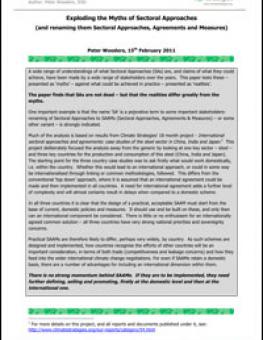
Exploding the myths of sectoral approaches (and renaming them sectoral approaches, agreements and measures)
There is a wide range of understandings of what sectoral approaches (SAs) are, and many different claims of what they could achieve have been made by a wide range of stakeholders over the years. This paper tests what it will call these "myths" against what could be achieved in practice, presented here as "realities."
The paper finds that SAs are not dead—but that the realities differ greatly from the myths.
One important example is that the name "SA" is a pejorative term to some important stakeholders: thus, the renaming of "sectoral approaches" to "Sectoral Approaches, Agreements and Measures" (SAAMs)—or some other variant—is highly preferable.
Much of the analysis is based on results from Climate Strategies' 18-month project, "International sectoral approaches and agreements: Case studies of the steel sector in China, India and Japan." This project deliberately shifted the analysis away from the generic by looking at one key sector (steel) and three key countries (China, India and Japan) for their production and consumption in this sector.
The starting point for the three country case studies was to ask firstly what would work domestically, i.e. within the country. This was followed by exploration of whether this would lead to an international approach, or could in some way be internationalised through linking or common methodologies. This differs from the conventional "top down" approach, where it is assumed that an international agreement could be made and then implemented in all countries. The need for international agreement adds a further level of complexity and will almost certainly result in delays compared to a domestic scheme.
In all three countries it is clear that the design of a practical, acceptable SAAM must start from the base of current domestic policies and measures. It should be built on and use these, and only then can an international component be considered. There is little or no enthusiasm for an internationally agreed common solution—all three countries have very strong national priorities and sovereignty concerns.
Practical SAAMs are therefore likely to differ, perhaps very widely, by country. As such schemes are designed and implemented, an important consideration will be how countries recognise the efforts of other countries, in terms of both trade (competitiveness and leakage concerns) and how they feed into the wider international climate change negotiations. For, even if SAAMs retain a domestic basis, there are a number of advantages for including an international dimension within them.
There is no strong momentum behind SAAMs. If they are to be implemented, they need further definition and promotion, starting at the domestic level before moving to the international.
You might also be interested in
Tree Planting for Climate Resilience in Freetown, Sierra Leone
This assessment presents the economic valuation of tree planting efforts in Freetown, Sierra Leone, including planting costs, added benefits, and avoided costs.
Sustainable Asset Valuation (SAVi) of a Small-Scale Tree Planting Initiative in Côte d'Ivoire
This report analyzes the social, economic, and environmental outcomes of a small-scale tree planting initiative at schools in Côte d'Ivoire.
December 2024 | Carbon Minefields Oil and Gas Exploration Monitor
In November 2024, 23 oil and gas exploration licences were awarded across five countries, with Russia granting the licences that account for the largest portion of embodied emissions.
The Cost of Fossil Fuel Reliance
Government support for fossil fuels reached at least USD 1.5 trillion in 2023, new data shows.